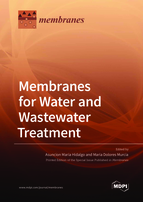Membranes for Water and Wastewater Treatment
A special issue of Membranes (ISSN 2077-0375). This special issue belongs to the section "Membrane Processing and Engineering".
Deadline for manuscript submissions: closed (15 August 2020) | Viewed by 77500
Special Issue Editors
Interests: water and wastewater treatment; membrane processes; fouling; modified membranes; recycle and reuse membrane; new materials
Special Issues, Collections and Topics in MDPI journals
Interests: water and wastewater treatment; membrane processes; fouling; modified membranes; recycle and reuse membrane; new materials
Special Issues, Collections and Topics in MDPI journals
Special Issue Information
Dear Colleagues,
Water is a vital element for life and the environment. The vast majority of water on the Earth`s surface (96%) is saline water in the oceans, and only a small volume of water has the quality to be used as drinking water. Water pollution has been documented as a contributor to a wide range of health problems. In recent years, water quality levels have greatly deteriorated because of rapid social and economic development and because it is used as a “dump” for a wide range of pollutants.
Many technologies have been developed to remove these pollutants. Among the different available treatments, “membrane technology” is one of the most viable alternatives, as it achieves high removal yields with low costs. For this reason, membrane separation processes play an important role in water and wastewater treatment. Different membrane processes, including microfiltration (MF), ultrafiltration (UF), nanofiltration (NF), reverse osmosis (RO), electrodialysis (ED), and pervaporation, have been used to treat water and wastewater. Besides these, membrane bioreactors (MBRs) have great potential for the treatment of municipal and industrial wastewater. In the last decade, new materials and fabrication processes have been developed to improve the performance of membrane synthesis and membrane-modification processes.
This Special Issue aims to cover recent developments and advances in all aspects of membrane and wastewater treatment, including membrane processes, combined processes (including one membrane step), modified membranes, new materials, the possibility of recycling and reusing membranes, and new technologies to reduce fouling and improve the efficiency of enhanced processes.
Both original research and review papers are welcome.
Prof. Asuncion Maria Hidalgo
Dr. Maria Dolores Murcia
Guest Editors
Manuscript Submission Information
Manuscripts should be submitted online at www.mdpi.com by registering and logging in to this website. Once you are registered, click here to go to the submission form. Manuscripts can be submitted until the deadline. All submissions that pass pre-check are peer-reviewed. Accepted papers will be published continuously in the journal (as soon as accepted) and will be listed together on the special issue website. Research articles, review articles as well as short communications are invited. For planned papers, a title and short abstract (about 100 words) can be sent to the Editorial Office for announcement on this website.
Submitted manuscripts should not have been published previously, nor be under consideration for publication elsewhere (except conference proceedings papers). All manuscripts are thoroughly refereed through a single-blind peer-review process. A guide for authors and other relevant information for submission of manuscripts is available on the Instructions for Authors page. Membranes is an international peer-reviewed open access monthly journal published by MDPI.
Please visit the Instructions for Authors page before submitting a manuscript. The Article Processing Charge (APC) for publication in this open access journal is 2700 CHF (Swiss Francs). Submitted papers should be well formatted and use good English. Authors may use MDPI's English editing service prior to publication or during author revisions.
Keywords
- water and wastewater treatment
- membrane processes
- fouling
- modified membrane
- recycle and reuse of membranes
- new materials








